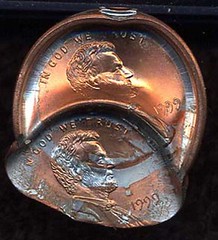
PREV ARTICLE
NEXT ARTICLE
FULL ISSUE
PREV FULL ISSUE
VOCABULARY TERM: MULTIPLE STRIKEDick Johnson submitted this entry from his Encyclopedia of Coin and Medal Terminology. Thanks. -Editor
Here is an instance where the same term has two meanings in numismatics, in this case whether it is a coin or a medal. They are given separate entries in the Encyclopedia and so numbered. Also to further explain this the process -- Multiple Striking – is also listed here. Multiple Strike. (1) The intended multiple striking, as a high relief medal, to bring up the full design relief intended by the artist. This obviously is done only in
a medal press and can occur from two to twenty or more times. See multiple striking, process set,  This mis-struck cent was struck three times before being ejected. The coin’s outer edge began to wrap around the edge of the die forming the raised edge. the final strike was off center. Photo: Fred Weinberg. Multiple Strike. (2) A mis-struck piece intended to be struck only once, but which has come between the dies two or more times by mechanical accident or human
caprice. See DOUBLE STRIKING, MIS-STRUCK. Multiple Striking. Using more than one blow to form a piece by striking in a press. Some coin relief items – coins or medals – are intentionally DOUBLE STRUCK, struck twice in a coining press engineered to perform a double blow. This is done without disturbing the blank so the register is perfect for the second blow. Should the blank be twisted between the first and second blow it will exhibit both images and will be called DOUBLE STRUCK. Proof surface items are often double struck on these special coining presses to effect a better strike, to impart a sharper image, with full angle edges at the rim/edge junction, and, for proof coins, the highly reflective proof surface. Art medals, on the other hand, are always required to have as many blows as necessary to bring up the relief intended by the artist; such multiple striking alternates with annealing (softening) of the struck blanks to relieve the work hardened metal. After each blow the partially struck up pieces are removed from the press, heat treated in a separate department, and returned to the pressroom to be placed back another time in the press for a subsequent blow; placing the partially struck blanks in the press is critical, the register must be perfect, or again a double struck image will appear. See PROCESS SET The physical characteristics of most metal alloys used for coins and medals are such that any metalworking process, particularly striking, causes stress in the metal and the piece becomes WORK
HARDENED – the molecules arrange themselves in such a way that further work will not easily alter their configuration. The piece must be annealed – by heating and rapid cooling – to soften the metal
and allow the molecules to flow easily again; this is particularly true of bronze and silver, the most popular composition for coins and medals. Thus art medals are struck a number of times necessary
to fill every cavity in the die to be fully STRUCK UP. See HEAT TREATING, WORK HARDENED.  Wayne Homren, Editor The Numismatic Bibliomania Society is a non-profit organization promoting numismatic literature. See our web site at coinbooks.org. To submit items for publication in The E-Sylum, write to the Editor at this address: whomren@gmail.com To subscribe go to: https://my.binhost.com/lists/listinfo/esylum All Rights Reserved. NBS Home Page Contact the NBS webmaster 
|